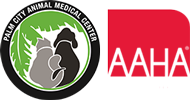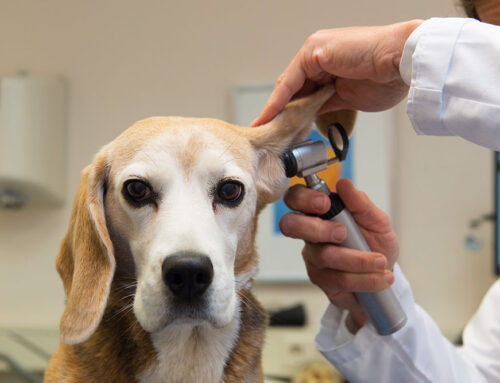Keeping a pet’s mouth healthy can feel overwhelming. We hear every day from families in Palm City who worry about anesthesia, cost, and the sheer logistics of scheduling a professional dental cleaning. Because non-anesthetic dental cleanings (NADs) are heavily advertised as quick, gentle, and inexpensive, it is easy to assume they are “good enough.” At Palm City Animal Medical Center, we want you to see exactly why that assumption can jeopardize not only oral health but overall well-being.
What actually happens during an anesthesia-free dental?
An NAD typically involves a pet being manually restrained while a scaler scrapes the visible tartar from each tooth. The procedure stops where the eye can see. There is no probing of periodontal pockets, no polishing to smooth micro-grooves, and no radiographs to reveal hidden disease. Although the marketing may sound reassuring, the science says otherwise; most periodontal destruction occurs beneath the gumline—precisely the area an NAD cannot reach.
The silent danger below the gumline
- Plaque hardens into calculus in as little as 48 hours.
- Infection travels down the root, destroying bone before outward signs appear.
- Chronic pain and bacterial showering of the bloodstream can follow.
A pet that looks “clean” after an NAD may still have advanced stage-3 periodontal disease brewing out of sight.
Why we recommend full anesthesia
When we place a patient under carefully tailored anesthesia, we gain three crucial advantages:
- Comfort and safety – A relaxed patient allows us to avoid forceful restraint, protecting the airway and preventing stress-related spikes in blood pressure.
- Comprehensive therapy – Ultrasonic scaling removes calculus above and below the gumline, and polishing smooths enamel to delay future buildup, as shown in Anesthesia and Dental Cleaning for Pets – AAHA.
- Diagnosis in real time – Full-mouth intraoral radiographs identify fractures, resorptive lesions, or early tumors that exterior exams miss. Oral tumors are rare but serious; early detection is lifesaving, as outlined in Oral Tumors of Small Animals.
Real-world issues NADs cannot solve
- Fractured teeth – A slab fracture of an upper carnassial looks like a small chip until an X-ray reveals an infected pulp. See Diagnosis and Treatment of Fractured Teeth for the treatment steps we follow.
• Retained baby teeth – Toy breeds often keep deciduous canines that crowd adult teeth; extraction should be done while the pet is anesthetized, as noted in Deciduous Canine Tooth Removal in Dogs.
• Malocclusions – Misaligned jaws rub enamel on enamel, causing pain and rapid wear. Management strategies are covered in ABCs of Veterinary Dentistry: Malposition and Malocclusion.
• Developmental problems – Cleft palate and other anomalies create lifelong dental challenges; learn more in Cleft Palate in Pets and Developmental Abnormalities of the Mouth and Dentition in Small Animals.
None of these conditions can be diagnosed—let alone treated—by scraping visible tartar.
Short- and long-term fallout of skipping proper dentistry
Short term:
- Gum lacerations from hand scalers without polishing leave rough surfaces that attract plaque immediately.
- Restraint-related anxiety can lead to head shyness the next time you try to brush at home.
Long term:
- Progressive periodontal disease results in tooth mobility, bone loss, and oronasal fistulas.
- Bacteremia has been linked to kidney, liver, and cardiac disease, concepts expanded upon in Healthy Mouth, Healthy Pet: Why Dental Care Matters.
- Chronic inflammation can trigger gingival overgrowth; see Gingival Enlargement in Dogs for genetic considerations.
Recognizing trouble early
Because animals instinctively hide discomfort, we encourage you to watch for:
- Breath that smells especially bad
- Dropping kibble or chewing only on one side.
- Pawing at the face
- Blood on chew toys
- Visible swelling
Any of these findings warrants a prompt oral exam.
When does dental disease become an emergency?
- A tooth root abscess that suddenly bursts can create a draining tract under the eye.
- Difficulty swallowing or excessive drooling may signal a rapidly growing mass.
- Jaw fracture secondary to severe bone loss is most common in small-breed seniors, a scenario described in the Guide to Dental Disease in Small Breed Dogs.
Emergencies like these require immediate veterinary intervention; an NAD offers no help and may worsen pain.
At-home habits that truly protect your pet’s mouth
We know daily brushing sounds daunting, yet it remains the gold standard. For families starting out, we recommend the following progression:
- Let your pet lick pet-safe toothpaste from your finger.
- Introduce a soft brush once acceptance is clear.
- Aim for gentle circles along the gumline for 60 seconds.
On busy days, dental treats and water additives carrying the Veterinary Oral Health Council (VOHC) seal can bridge the gap, though they never replace professional cleanings.
For toy breeds prone to overcrowded teeth—see the American Kennel Club’s overview Trouble with Toy Teeth—we may also suggest more frequent cleanings or orthodontic interventions.
What we do during a professional dental at Palm City Animal Medical Center
- Pre-anesthetic bloodwork assesses organ function.
- IV fluids maintain blood pressure and support kidney perfusion.
- A dedicated technician monitors ECG, blood pressure, oxygen, and temperature.
- Ultrasonic scaling, subgingival curettage, polishing, and fluoride are performed.
- Full-mouth radiographs guide any extractions or other therapies. Imaging is indispensable, as detailed in The Importance of Dental X-Rays for Pets.
- We apply local nerve blocks and provide postoperative analgesia to keep recovery smooth.

Frequently asked questions
How often should a healthy adult dog or cat have a professional cleaning? Most benefit from an annual procedure, but brachycephalic breeds or patients with systemic disease may need one every six months. We individualize plans during routine exams.
Is anesthesia safe for seniors? Age by itself is not a disease. Pre-op diagnostics and customized drug protocols allow us to anesthetize geriatric pets safely, and the systemic benefits of resolving infection frequently outweigh the anesthetic risk.
Can a prescription diet alone prevent tartar? Specialized kibble can slow accumulation, yet cannot remove existing calculus or address periodontal pockets.
Our commitment to you and your pet
We share your goal of a comfortable, healthy life for every companion under our care. By choosing a complete, anesthetized dental procedure—and by embracing consistent home care—you are preventing pain, preserving organs, and adding happy years together.
If you have questions about anything you have read here, our doctors and nursing staff are just a click away through our contact page. To explore the full range of preventive and surgical dentistry we offer, please visit our veterinary services menu.








Leave A Comment